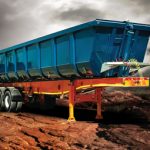The intricacies of Truck Test 2014

Tough healthy competition, between the truck manufacturers that entered Truck Test 2014, was evident right from the start of this year’s test. With current high fuel and operating costs, the participating manufacturers were all keen to prove that, correctly driven and maintained, their vehicles are economical to own and operate.
Truck Test 2014 was run as a demonstration of what vehicles in the three- to four-tonne payload segment are capable of achieving in a typical operating environment. The results will provide potential buyers, of this class of vehicle, with excellent information on the associated operating costs.
The HTM TransSolve software was used to simulate the route and Ctrack provided the technology to track all the vehicles during the test. The vehicle-tracking system proved to be an excellent management tool to keep an accurate control on the vehicles during the test, as well as when corroborating the data afterwards.
This ability to monitor the vehicle speeds was well utilised by the control team during the test runs to check that vehicles kept within the speed guidelines, which had been set. The participants settled on a highway test speed limit of 80 to 100 km/h – this was a gentleman’s agreement amongst everyone. It should be noted that some of the participants did not adhere to this agreement.
 To simulate typical operating conditions, a three-day programme was selected. On the first day, the fully loaded vehicles were run from the Engen Umfula One-Stop service station at Hartebespoort to Belfast; a return distance of 511 km.
To simulate typical operating conditions, a three-day programme was selected. On the first day, the fully loaded vehicles were run from the Engen Umfula One-Stop service station at Hartebespoort to Belfast; a return distance of 511 km.
This route is reasonably tough, with an approximate 600 m climb from the start to Belfast, which is about 1 945 m above sea level. What also made it tough is that, on route, there are many hills and dales, as well as the heavy traffic conditions around Pretoria during the late afternoon.
On returning to the Engen Umfula One-Stop, the vehicles were refuelled. This was accurately done with the aid of a sight glass, which was attached to the fuel tank, and readings were carefully recorded. The vehicles were then parked for the night.
On the second day, the vehicles were taken to the Gerotek test track. The tests took place on the Ride and Handling Track, simulating a stop-start operation with steep gradients. After completing the run for the day, the vehicles returned to the Engen Umfula One-Stop to be refuelled. The total distance travelled during the day was 94,7 km.
The vehicles were then off-loaded in preparation for the third day’s test, which again took them on the same route as the first day; to Belfast and back. This run simulated the empty return leg of a typical journey. Vehicles were, again, carefully refuelled in order to obtain accurate fuel consumption data.
Another factor that made this year’s test interesting was that four of the vehicles entered were equipped with automated manual transmission (AMT) and one vehicle was equipped with a fully automatic transmission. The remaining vehicles were fitted with standard manual transmissions.
Good fuel consumption was obtained by all the vehicles participating in the test, irrespective of the type of transmission fitted. Many of the drivers, who were driving vehicles equipped with AMT, used both the automatic and manual gear change operating modes during the test to obtain optimum fuel consumption.
This clearly highlighted the important need for drivers to be trained to correctly drive a vehicle fitted with AMT, in order to obtain optimum fuel consumption and long vehicle-component life.
The test results highlight the fact that all the vehicles that participated in Truck Test 2014 are capable of transporting goods economically, provided that the drivers are correctly trained and the vehicle is well maintained.
One of this country’s most respected commercial vehicle industry authorities, VIC OLIVER has been in this industry for 49 years. Before joining the FOCUS team, he spent 15 years with Nissan Diesel (now UD Trucks), 11 years with Busaf and seven years with International.
Published by
Focus on Transport
focusmagsa




